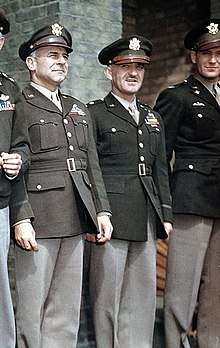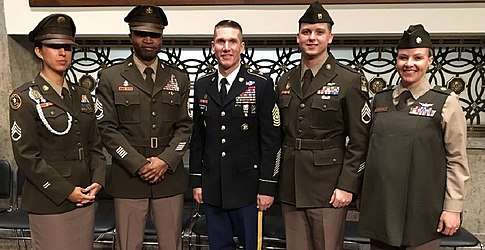Pinks and greens
"Pinks and greens" and "Army greens" are colloquial terms for the United States Army's officer winter service uniform of the early 20th century and the planned, similarly patterned, service uniform of the early 21st century.

"Pinks and greens"
The "pinks and greens" uniform was introduced in the 1920s and consisted of a brownish green blouse (the "greens") with lighter colored trousers[1] of a slight pinkish hue (the "pinks"). Accessories – which, until 1942, included a Sam Browne belt – were patterned in brown leather. In 1944, an optional field jacket, sometimes called the Ike jacket due its association with Dwight Eisenhower, was introduced. [2][3]
Beginning in 1948, wear of the uniform by officers was restricted to off-duty hours and informal evening social functions. The uniform was altogether deauthorized for officers of the United States Army effective February 1, 1958, and for officers of the United States Army Reserve and the Army National Guard of the United States effective October 1, 1959.[2]
The "pinks and greens" have been called "one of the flashiest and most striking uniforms ever authorized by the Army".[3]
"Army greens"

After a 60-year hiatus, on November 11, 2018, the U.S. Army announced it would adopt a new uniform patterned on the "pinks and greens" effective 2020, with phase-in to be complete by 2028.[3] The decision to adopt the new uniform was done to fill the gap between the formal blue Army Service Uniform and the Army Combat Uniform created by the deauthorization of the Green Service Uniform used between 1954 and 2015. With the change, the blue Army Service Uniform will again be restricted to ceremonial wear.[4][5][6][7]
According to former Sergeant Major of the Army Daniel A. Dailey, the Army designation for the new uniform is "Army greens" rather than "pinks and greens"[4], although it is still often called by the traditional nickname.
References
- Authorised for commissioned officers only in paragraph 3b of AR 600-35, 1924
- Stanton, Shelby L. (1998). U. S. Army Uniforms of the Cold War, 1948–1973. Stackpole Books. pp. 44–45. ISBN 0811729508.
- Mack-Jackson, Benjamin. "Old Uniform is New Again". ausa.org. Association of the United States Army. Retrieved November 17, 2018.
- Robson, Seth (November 15, 2018). "Don't call them 'pinks and greens': Top enlisted soldier says there's another name for the Army's new dress uniforms". Stars & Stripes. Retrieved November 17, 2018.
- "'Pinks and greens' are the throwback jersey the Army needs". ngac.org. National Guard Association of California. Retrieved November 17, 2018.
- "Army getting new uniforms; service returns to WWII-era 'Pinks and Greens'". WTVY-TV. November 14, 2018. Retrieved November 17, 2018.
- Milzarski, Eric (November 15, 2018). "The US Army announced the comeback of the iconic WWII-era 'Army Greens.' Here's what you should expect". Business Insider. Retrieved November 17, 2018.